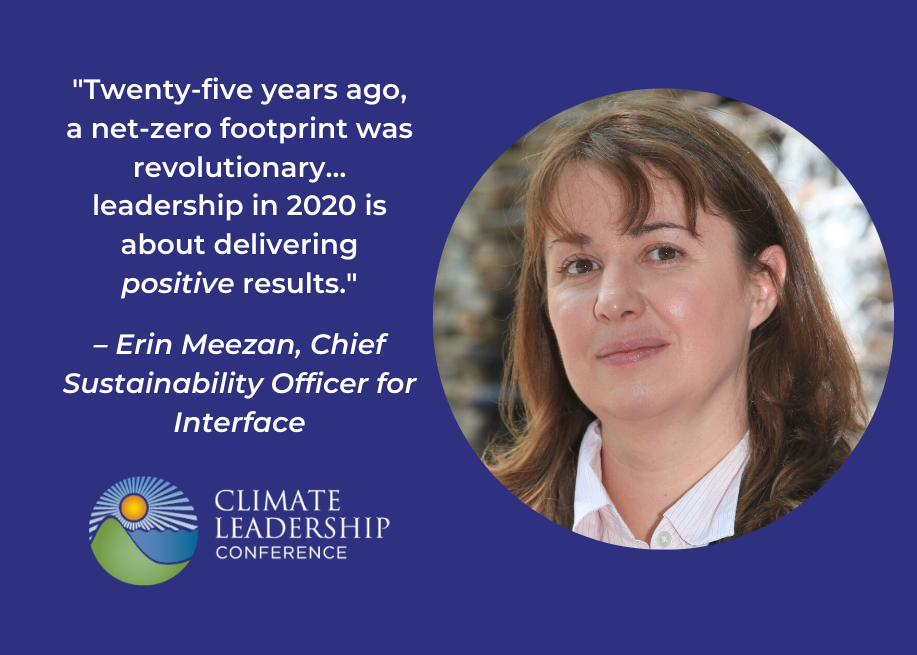Erin Meezan is the Chief Sustainability Officer at Interface, the groundbreaking global commercial flooring company that is committed to running their business in a way that is restorative to the planet and creates a climate fit for life.
Don’t miss Erin’s discussion during the closing plenary session of the Climate Leadership Conference – Beyond Zero: Introducing the Climate Take Back.
Since you’ve been working with Interface, how has the landscape for sustainability changed? Have the goalposts shifted?
I’ve been working in sustainability for over 20 years, I’ve been with Interface for over 15, and this summer marked the 25th anniversary of our founder and former chairman Ray Anderson’s game-changing speech. Back then he challenged our company to become a sustainable enterprise with the goal of having net-zero impact on the environment. Mission Zero® made us a pioneer, learning how to define and implement sustainability at a time when few companies were pursuing it.
We focused on three key areas of the business: our factories, our products and our raw materials. Over the last 25 years, we’ve made remarkable progress, with results including:
- a 92 percent reduction of waste to landfill across our global factory locations;
- an 89 percent water use reduction in factories globally;
- a shift to 89 percent of our global energy coming from renewable sources, with 100 percent of our electricity globally covered by renewable sources; and,
- a 69% reduction in the carbon footprint of our products.
Fast forward to 2019 and a number of things have changed. First, sustainability leadership is no longer about having targets focused on lessening the environmental impact of your business. Twenty-five years ago, a net-zero footprint was revolutionary. Five years ago, we realized this wasn’t enough: we needed to shift from do-no-harm ethos to a new kind of benchmark focused on delivering positive results.
By 2016 we were close to achieving Mission Zero so we set a new mission focused on what we perceive to be the biggest challenge: carbon. Instead of setting targets against our prior performance, we asked what the planet needs us to deliver.
What are the biggest challenges in this new approach to sustainability?
One of the challenges in terms of results is that our biggest carbon impact is in our supply chain, so we can’t take direct action to mitigate it. We need to educate, influence and advocate for the change we want to see. We have worked very hard to build awareness and increase engagement around these issues through our relationships with our suppliers and by doing things like bringing in guest speakers to talk to them. We’ve also been able to affect change through competition. For example, we have told our yarn suppliers that whoever gives us recycled content first will enjoy the majority of our business.
We’re also trying to use our influence on a broader scale by pushing for legislation that can make a difference. In the past three years we have worked with a lobbyist in California to influence and pass amendments to California’s innovative carpet recycling law. We also intend to engage more deeply on making sure that the State incorporates sustainability at the front end of this cycle through innovative purchasing practices that prioritize sustainability considerations – and particularly carbon emissions. We’re seeking to amend California’s “buy clean” legislation, which passed in 2017, so that it includes not just construction materials like steel and cement, but also interior building products like flooring. For example, when a state agency is going to build a new building or undertake significant construction, they should consider embodied carbon as a screen in construction and interior finished materials. We’re trying to expand this to all built environment materials. If just our business goes carbon negative, we won’t stop global warming…but the ripple effect in the government, corporate and university sectors could have a huge impact.
Another different kind of challenge is that we need a whole new set of metrics to measure positive impacts. Some great progress has been made through the Handprint methodology, but we are definitely at the beginning of the journey when it comes to measuring progress against these kinds of targets.
What is the biggest opportunity?
If you look at the square footage of new commercial construction and renovations between now and 2050, we are building the equivalent of a new New York City every month for the next 40 years. We think embodied carbon in the built environment has been a huge blind spot, and one that architects and designers can readily address. Over the next two decades, we want to work with architects, interior designers, design firms, and big companies on decarbonizing the built environment by funding tools like the Embodied Carbon in Construction Calculator (EC3) tool, by supporting policy, and by having an influence wherever we can – if every one of our sales people talks to two people every day, we can have a big impact on changing hearts and minds.
Last month was exciting because embodied carbon calculator tool was launched – it’s a free open-source tool that allows customers to see and compare construction and interiors materials for free. This puts good information in the hands of consumers so they can make choices that have a more positive impact on the environment.
Tell me about the Carbon-Negative Company initiative.
Our goal is to get our company to carbon negative by 2040. That means that we remove more carbon than we produce. We introduced a prototype carbon-negative product in 2017, one that stores more carbon than it emits. Building on the lessons of that prototype, we commercialized the first carbon-negative carpet backing in 2018, and in 2019 we invested in new raw materials and technology to make or offer carbon-negative products to customers in 2020. This was possible through a combination of shifting to backing materials that are bio-based and recycled materials that store carbon, introducing new manufacturing processes and new technologies, and using renewable energy and more efficient processes.
Now that we’ve proven that the product is market ready, we’re working on getting state procurement agencies to demand it, and to have companies put it in their RFPs and specifications. We’re more optimistic than ever – if we can develop a carbon-negative product in five years, so can every flooring manufacturer and drywaller and cement company. The possibilities are very exciting.
What have you learned so far on the path to negative carbon?
The status quo is hard to overcome. I think that we’re learning that a new challenge like carbon negative leads you to look in directions you previously were not. It also seems hard and expensive, but we’ve proven that starting with a prototype approach, we’ve been able to shift toward carbon-negative products in a short timeframe. We’re also learning that our customers have a strong desire to address carbon in the built environment, but they need the tools and the products to do it. Many people seem to believe that it will take too much capital to transition to low carbon or negative carbon economy. One of the things we’ve found over the last four to five years is that, by challenging our folks to create a carbon-negative product, we’ve looked at raw materials we’ve never looked at before and we’ve become more innovative than ever.
It’s clear that global climate change is a huge issue but many individuals feel disempowered, and aren’t sure what to do. If you can link what they do – such as picking materials for their built environments – with a positive impact, it makes them feel like they can do something.
What are you looking forward to at the 2020 Climate Leadership Conference?
The shift we’re seeing in the level of corporate ambition on climate is fierce, and I’m also excited about the growth of the Science-Based targets movement. I’m looking forward to hearing more about those ambitions and how to action them in terms of a business plan. We don’t have the pathway to carbon negative completely figured out – we have the products, but still have a ways to go on our supply chain, operational footprint, and raw materials – so I’m interested to get ideas from others on how we motivate people to move in that direction…how do we link all this work we’re doing and unlock the connection with people? What do we want to accomplish collectively? This is an incredibly important and timely conversation and I’m happy to be part of it.

